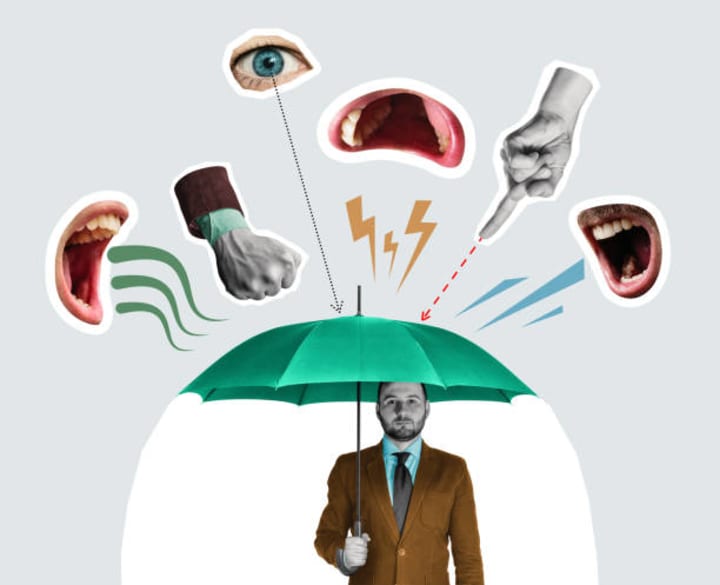Unseen Struggles
A Journey Through Mental Health in the Workplace

Once upon a time, in a bustling city, there was a prestigious advertising agency called "Creative Horizons." On the surface, it seemed like a thriving and vibrant workplace, filled with creative minds and innovative ideas. However, beneath the facade of success, there were hidden struggles that no one could see.
Sophia, a talented graphic designer, was one of the agency's rising stars. Her colleagues admired her work, but they couldn't fathom the turmoil she was facing internally. Every day, Sophia battled crippling anxiety and self-doubt, often triggered by tight deadlines and high-pressure projects. She struggled to sleep at night, her mind constantly racing with thoughts of inadequacy.
Despite her struggles, Sophia was afraid to reveal her mental health challenges. She feared being judged or considered weak by her peers and supervisors. Instead, she put on a brave face and kept her pain hidden, wearing a mask of confidence.
One day, Sophia's supervisor, Daniel, noticed a change in her behavior. He saw her withdrawing from group discussions and noticed her decline in productivity. Sensing something was amiss, Daniel approached Sophia discreetly, expressing concern and offering a listening ear.
At first, Sophia hesitated to open up, but Daniel's genuine empathy and non-judgmental approach created a safe space for her to share her struggles. Tears welled up in her eyes as she finally spoke about her anxiety, the pressure she felt to maintain a perfect image, and her fear of being seen as weak.
To Sophia's surprise, Daniel listened attentively and reassured her that her mental health mattered, and it did not diminish her talent or value to the team. He encouraged her to seek professional help and assured her that the company would support her during her journey to recovery.
With Daniel's encouragement, Sophia began attending therapy sessions and gradually learned coping mechanisms to manage her anxiety. The agency's HR department also initiated mental health awareness programs, workshops, and counseling resources, making it easier for employees to seek help without fear of judgment.
As time passed, Sophia's mental health improved, and she started to thrive both personally and professionally. She felt a newfound sense of belonging and support within the workplace. Creative Horizons' culture began to shift as well. More employees felt comfortable discussing their mental health challenges, and the stigma surrounding mental health slowly dissolved.
Sophia's recovery journey inspired other employees to open up about their own struggles. They formed a support group where they could share experiences and provide encouragement to one another. Creative Horizons became a place where mental well-being was openly discussed and prioritized.
As the years passed, Creative Horizons flourished, not just in terms of creative output but also in fostering a supportive and compassionate work environment. Their success was attributed not only to the brilliant ideas generated by the team but also to the culture of empathy and understanding that they had embraced.
Sophia's story had shown that mental health challenges could affect anyone, regardless of their talent or success. It underscored the importance of creating an inclusive and supportive workplace that acknowledged and addressed mental health issues.
The tale of "Creative Horizons" became a source of inspiration for other companies, leading to a movement in the business world towards greater mental health awareness and support. Through these efforts, workplaces across the city and beyond began to break down the barriers surrounding mental health, transforming into havens where employees could thrive both professionally and personally.

Introduction
Mental health in the workplace is a critical issue that demands attention and action. With many employees spending a significant portion of their lives at work, the work environment plays a pivotal role in their overall well-being. This article delves into the importance of addressing mental health in the workplace, the impact of a supportive work culture, common challenges faced by employees, and practical strategies to foster a mentally healthy work environment.
The Significance of Mental Health in the Workplace
Mental health in the workplace is not only a matter of employee well-being but also a key determinant of productivity, job satisfaction, and overall organizational success. Employees facing mental health challenges may experience decreased productivity, absenteeism, presenteeism, and high turnover rates. By prioritizing mental health, employers can create a positive work culture that encourages open dialogue, understanding, and support.
The Impact of a Supportive Work Culture
A supportive work culture is instrumental in promoting mental well-being among employees. When employers create an environment that acknowledges mental health issues without stigma, employees feel valued and are more likely to seek help when needed. Encouraging work-life balance, providing flexibility, and offering mental health resources demonstrate an organization's commitment to its employees' well-being.
Common Mental Health Challenges in the Workplace
Several factors contribute to mental health challenges in the workplace. High levels of stress, demanding workloads, tight deadlines, lack of job control, and poor work-life balance can lead to burnout and anxiety. Additionally, workplace bullying, discrimination, and microaggressions negatively impact employee mental health. The fear of disclosing mental health issues due to perceived stigma or potential career repercussions often prevents employees from seeking help, exacerbating their struggles.
Practical Strategies for Fostering Mental Health
Encourage Open Communication: Create a culture where employees feel comfortable discussing mental health concerns with supervisors and colleagues. Promote mental health awareness through workshops and training sessions.
Provide Mental Health Resources: Offer access to employee assistance programs (EAPs), counseling services, and mental health helplines. These resources can be crucial in supporting employees facing challenges.
Promote Work-Life Balance: Encourage flexible work arrangements, promote realistic workloads, and discourage long working hours. Encouraging breaks and time off helps employees recharge and reduce stress.
Establish Anti-Stigma Campaigns: Educate employees on mental health issues, combat misconceptions, and challenge stigmatizing attitudes. Promote a culture of empathy and understanding.
Training for Managers: Provide managers with mental health awareness training to recognize early signs of distress in employees and offer appropriate support.
Address Workplace Stressors: Assess and address factors contributing to workplace stress, such as unclear expectations, inadequate resources, and poor management practices.
Promote Physical Well-being: Encourage physical activity, healthy eating habits, and access to wellness programs, as physical health influences mental well-being.
Encourage Peer Support: Foster a supportive network among employees, where they can discuss challenges and offer each other encouragement.
Conclusion
Prioritizing mental health in the workplace is an investment that benefits both employees and organizations. By fostering a supportive work culture, offering mental health resources, and addressing workplace stressors, employers can create an environment where employees thrive mentally and emotionally. Recognizing the significance of mental health in the workplace and taking proactive steps to support employee well-being will lead to a more engaged, productive, and resilient workforce, ultimately contributing to the long-term success of the organization.
About the Creator
Enjoyed the story? Support the Creator.
Subscribe for free to receive all their stories in your feed. You could also pledge your support or give them a one-off tip, letting them know you appreciate their work.





Comments (1)
Hello, AI is permitted on Vocal. It is a Vocal policy that content created with AI is identified as such at the start of the story/article. Your article/story has many hallmarks of AI-assisted/generated content. You can find the details of the Vocal policy here: https://vocal.media/resources/an-update-from-vocal-on-ai-generated-content, Please amend your piece to be in compliance. If you are not a Vocal+ member you will need to contact Vocal here ([email protected]) and ask them to edit your story/article/poem for you. If you don’t correct this the content may be removed by Vocal and/or you may be deleted from the platform.